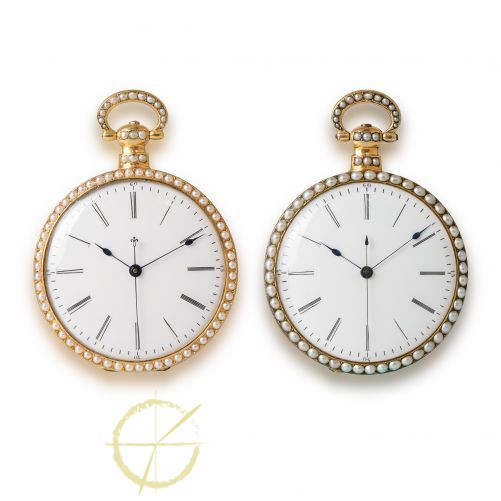A Pair of Bovet Chinese Market Enamel Painting Pocket Watches
Inventory Number: PW2303001ALC& PW2303001BLC
Made circa 1860, unsigned, attributed to Bovet. 62mm, gilt brass case with pearl-set bezel, pendant, and bow. The polychrome enamel painting scene depicts flower bouquets on a blue ground. This type of motif is one of the most popular themes specially made for the Chinese market. A pair of matching mirror-image pocket watches with consecutive No. 4228 and No. 4229. White enamel dial with Roman numerals and blued-steel spade hands.
A gilt Tixier caliber, entirely engraved with scrolled flowers (in Chinese, they prefer to describe these kinds of patterns as clouds, duplex- Jacot escapement, which allows the central seconds hand to advance each second. Accompanied by enameled winding key.
Functions: hours, minutes and jumping seconds.
On loan from the private collection of Mr. Yeung Sau Wong.
Brand History
Bovet Fleurier SA is a Swiss brand of luxury watchmaker registered on May 1, 1822, in London, U.K. by Édouard Bovet for the purposes of manufacturing watches exclusively for the Chinese market. It is most noted for its pocket watches manufactured for the Chinese market in the 19th century. In 1823(the 3rd year of the DaoGuang Emperor), the Bovet brothers established a company in Canton, China, later due to the Opium War, they were forced to their family and business to Macau for a while. It was about this time that the company created a Chinese name to market to the middle class more effectively. The Chinese name for Bovet, "Bo Wei", became a common noun for watches in China for many years. Now they still produce high-end artistic watches.
Glossary of Material Terms
Enamel
A vitreous substance which main component is silica(also may have borax, lead, and potash)mixed with oxides (transition metals) that create a vast palette of colors. Enamel can be used to decorate metal surfaces, gold, silver, and copper.
Painting on the Enamel
A gold or copper plate is coated with base enamel and then fired. The colors are in powder form which the enamel-painter dilutes as and when they are needed using an oily or semi-oily essence, before applying them with a fine brush. Each color is dried and then fired before the next is applied. A work can be fired numerous times.
The Chinese market pocket watch is the pocket watch that was specially made for the Chinese market in the 18th to 19th centuries by European watchmakers. It was originally used as a tribute to the Qing Dynasty royal family and spread among the public gradually. Many cases were generally made of silver, brass, gilt-brass, or silver, and decorated with painted enamel with pearls or precious jewels.
The movements are so-called “Chinese Caliber”, and many of them were engraved with beautiful patterns such as scrolled flowers and foliage, the designs were significantly recognizable. From the Chinese collectors ‘view, these kinds of pocket watches are called "The big-eight pieces”. (There is such a statement that the movement was usually designed to consist of a barrel and seven main components, eight pieces in total, and “eight" is considered as the homonym of "fortune" in Chinese, so they were gradually known as "The big-eight pieces" from the 19th century in Chinese.
The Duplex-Jacot escapement, like any duplex escapement, is a frictional one the friction from the escape wheel is constantly present. Enabled inexpensive production of dead center-second watches it was often used in the watches made for the Chinese market. Jacot, Charles Edouard (1817-1897), once worked in La Chaux-de-Fonds, Le Locle, Baltimore, and New York. He was a prolific inventor and innovator, especially of escapement work. At the age of 19, he visited his cousin, the son of Abraham Perrelet, in Le Locle and became involved with watchmaking. In 1837, he went to New York City, where he was to stay for 20 years. Jacot invented a modification of the duplex escapement with a dead center-seconds hand, known as the “Duplex-Jacot”, used extensively in watches made for the Chinese market (US invention Patent No. 9 150, July 27, 1852). While in America, he registered 12 American patents for perfecting the construction of watches, including the “star wheel duplex” escapement, patented on July 20, 1852, and a stop-watch feature, patented on June 8, 1858, by which time Jacot had already returned to Switzerland. There he founded the Jacot & Salzmann firm in La Chaux-de-Fonds. By the 1870’s his firm was called Charles E. Jacot. One of the founders of the Société inter-cantonale des industries du Jura (Intercantonal Societies of Jurassian Industries) along with Longines. Charles Jacot died in August 1897.









